The owners of the North Conway ski area are trying to balance tradition with long-needed investment
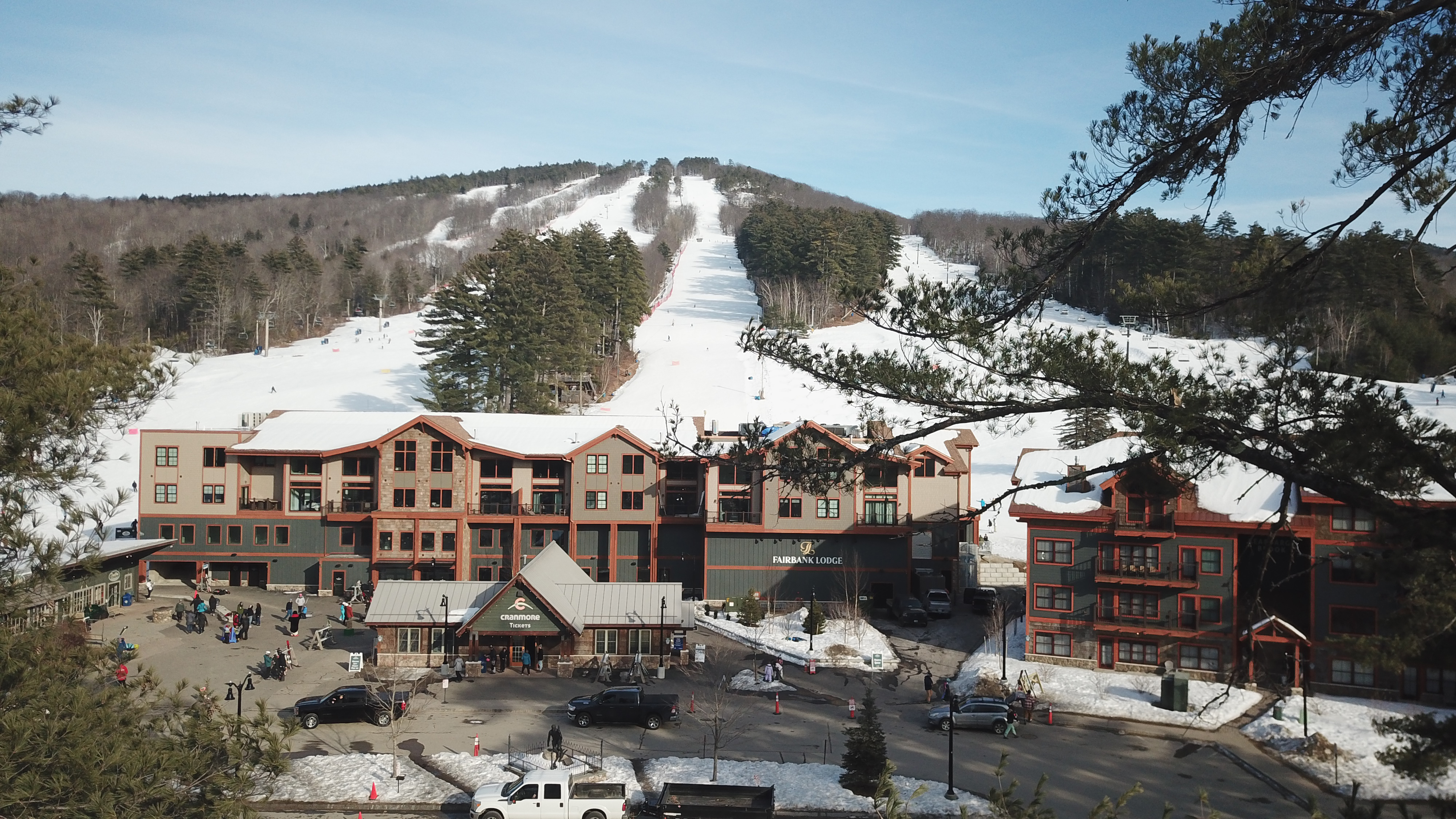
The
new Fairbank Lodge, which opened in late 2023, and the Kearsarge Brook
Condominium complex, right, completed in 2020, dominate the base area of
Cranmore Mountain Resort. (Courtesy of Cranmore Mountain Resort) For visitors who haven’t stopped by Cranmore Mountain Resort recently, be prepared. This is no longer your father’s, or grandfather’s, cherished North Conway ski area. That’s not to say it’s not better. But it is certainly different. And the changes that have been implemented in many ways reflect the changing face of the ski industry.
Over the past 14 years, owners Brian and Tyler Fairbank and Joseph O’Donnell, under the watchful eye of general manager and president Benjamin Wilcox, have transformed this well-loved hill into a solid mid-sized resort. More than $65 million has been invested into the area’s snow-making and grooming facilities, lift capacity, main lodge, resort amenities and lodging options.
Therein lies the rub.
Those changes, say Wilcox and longtime journalist and author Tom Eastman, have also changed the look and feel of the ski area. Depending on your perspective, those changes have been celebrated, or met with skepticism.
“There are some people who lament the loss of the old Cranmore,” says Eastman, who wrote the 1989 “Flight Without Wings: A Celebration of Hannes Schneider and 50 Years of Skiing at Mount Cranmore” and the 2012 “History of Cranmore Mountain.” “As Ben Wilcox says, Cranmore needed a hug, and that’s what the Fairbank Group has given it. And modernized it.”
Cranmore is one of a triumvirate of nostalgia-laden ski hills in the Mountain Washington Valley, all of which share a common history but stand in stark contrast to one another today. In Pinkham Notch, the venerated Wildcat boasts the region’s best views of Mount Washington and the magnificent Tuckerman Ravine. It also boasts exceptional terrain, building on trails first carved by the Civilian Conservation Corps during the Great Depression. This is an old-school ski area, without overnight accommodations. The old lodge is a bit threadbare, but that translates to “character” for most fans.
Meanwhile, in the serrated hills outside Jackson, Black Mountain (formerly
Whitney’s) continues to chug along, albeit in fits and starts. First
opened in 1937, the area has been teetering on the cusp of closure the
past few years, and is unquestionably showing its age. Recently
purchased by Indy Pass, Black is now being considered for a cooperative
ownership arrangement similar to Mad River Glen in Vermont.
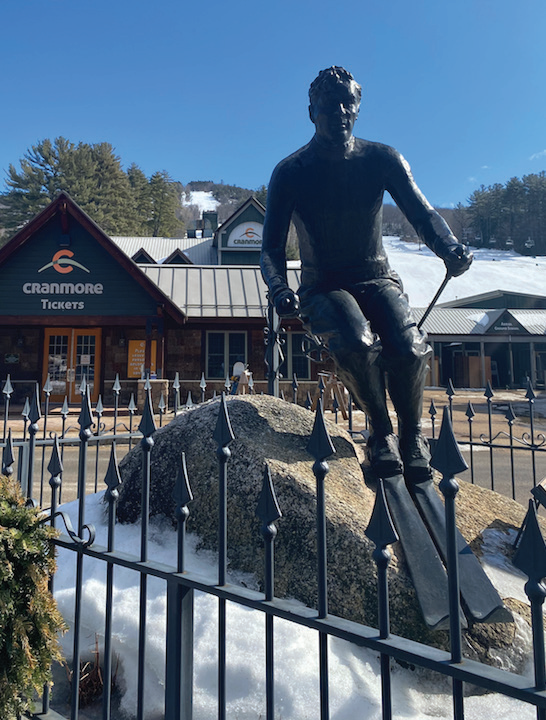
A
bronze statue of the “Father of Modern Skiing,” Hannes Schneider,
created by sculptor Edward Materson, was unveiled in February 1989,
during the 50th anniversary celebration of Schneider’s arrival. It still
welcomes visitors at the roundabout by the resort’s ticket office. (Courtesy of Cranmore Mountain Resort)
By
contrast, Cranmore has enjoyed 14 years of fairly consistent
development. First opened in 1938 by North Conway native son and
legendary financier Harvey Dow Gibson, after renting a rope tow from ski
shop founder Carroll Reed and moving it to Cranmore Mountain, the ski
area has deep roots in a community that is synonymous with the sport.
Just this year, North Conway was named the country’s “Best Ski Town” in USA
Today’s 10 Best 2024 Readers’ Choice Awards, and Cranmore, with its rich
traditions, is a major reason why. Tales of the ski trains that brought
a pioneering generation of skiers to New Hampshire’s north country,
George Morton’s radical-but-distinctive Skimobile lift, the
establishment of the Eastern Slope Inn and subsequently the Eastern
Slope Ski Club, are the stuff of local lore.
Gibson
also brought Reed’s ski school, with its crew of Austrian ski
instructors, including Benno Rybizka, to Cranmore. In 1939, Gibson
flexed his financial might to pry the “Father of Modern Skiing,”
Austrian Hannes Schneider, founder of the world’s first ski school in
1907, from Nazi Germany. Schneider, who developed the renowned Arlberg
Technique, put his stamp on North Conway, bringing a new cachet to the
area and convincing Gibson to expand Cramore’s ski trails to the top of
the mountain.
A bronze
statue of Schneider, unveiled during Cranmore’s 50th anniversary
celebration of Schneider’s arrival in 1989, still greets visitors at the
roundabout by the area’s ticket office. Schneider and his son, Herbert,
were tireless advocates of the Eastern Ski Slope Junior Program that
introduced thousands of local children to skiing, for free, and
continues to this day. That program, in addition to the Local Yokel
Recreational Ski League (now the Mountain Meisters), helped create a
sense of ownership among residents and longtime visitors.
Wilcox,
a resident of the Mount Washington Valley for more than 40 years, since
he was in high school, took the reins of the ski area in 2004 and was
quickly immersed in Cranmore’s traditions.
“I
instantly met Herbert Schneider, the son of Hannes,” he says. “It was
like coming into ski royalty, being at Cranmore, because there were so
many people that had been here forever and been part of the history. It
wasn’t until I got here and realized, oh my god, there is this culture
and multigenerations that have skied here.”
Herbert Schneider and several partners bought Cranmore from Gibson’s widow in 1963, and ran it until 1984.
After
Les Otten’s American Skiing Company purchased Cranmore in 1995, the
area became a political football, and Otten sold it a year later to
Booth Creek Holdings.
Despite an initial infusion of capital, by 2004 Booth Creek officials
no longer considered Cranmore a part of their long-term plans, Wilcox
says.
Everything
changed, and changed rapidly, with the arrival of the Fairbank Group in
2010. Wilcox acknowledges that the success of Brian Fairbank at Jiminy
Peak in Massachusetts was critical in convincing him that they were the
right owners to write Cranmore’s next chapter.
“When
the Fairbanks came in and looked at the mountain, they said: ‘Oof, this
place is tired. You need bubblegum and duct tape to keep it together,’”
Wilcox says.
“It quickly dawned on me that, if we don’t find the right partner here, this place might not be here.”
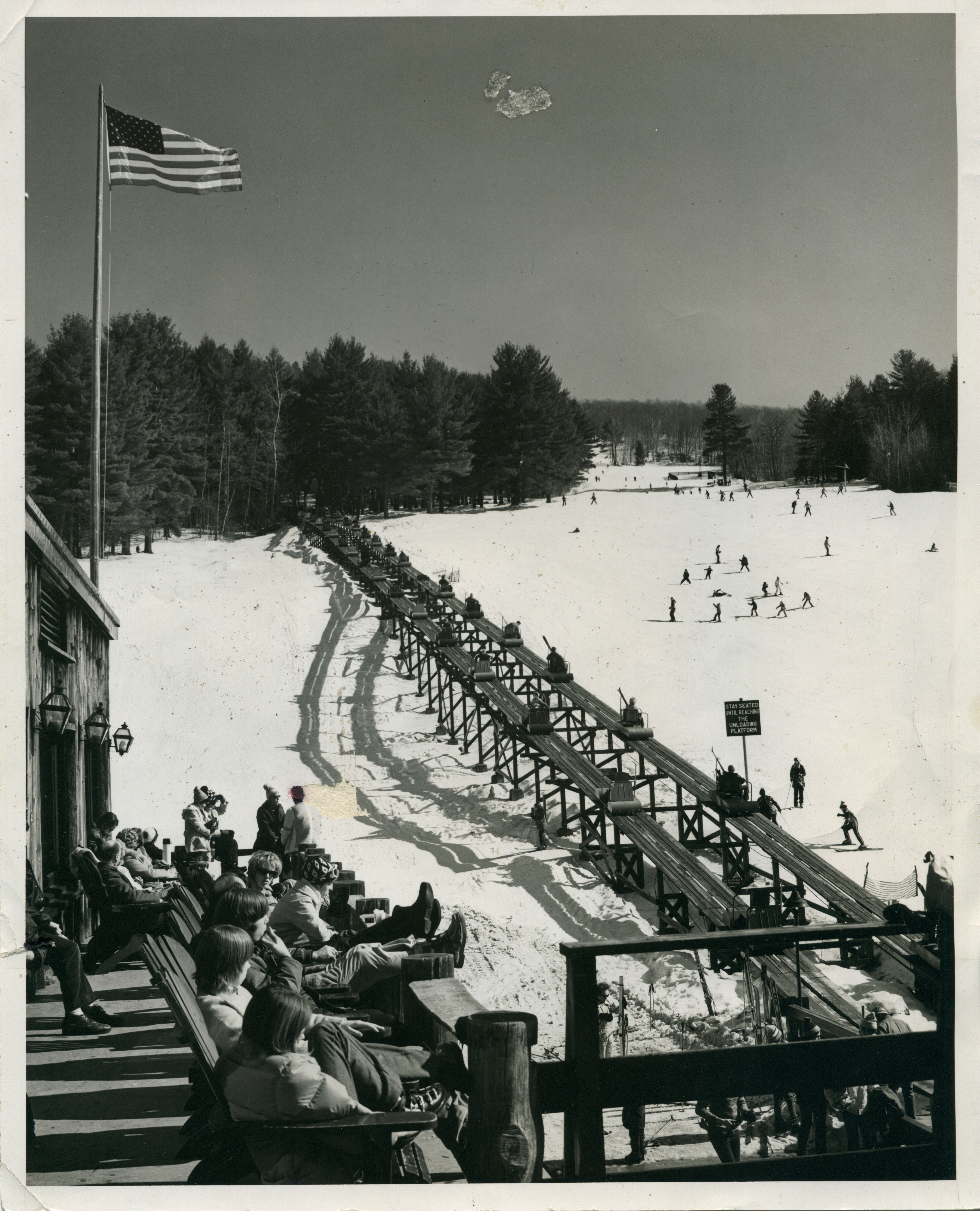
Goodrich Falls mechanic
George Morton built the distinctive Skimobile lift, which transport
Cranmore skiers up the hill for almost 50 years, starting in 1938. (Courtesy of Cranmore Mountain Resort)
The
Fairbanks infused new capital, expanding snowmaking and grooming
capacity, the tubing park, and the state-of-the-art Arlberg Children’s
Center, and retrofitting the resort’s chairlifts. In 2011, Cranmore
launched summer operations, including a mountain coaster, and in 2016,
the Fairbanks broke ground base-area redevelopment project.
The
first phase included Kearsarge Brook Condominiums, with 18 residences,
followed by the Artist Falls Lodge in 2021, the Fairbank Lodge (with 15
condominiums) in 2022, the 89-room Fairfield Inn & Suites by
Marriott in 2023, and the first phase of the Lookout Lodge (17
condominiums) in 2024. Two more additions to the Lookout Lodge, with 42
more condominiums, new ski school and rental facilities, and a new
restaurant will complete the anticipated $85 million project.
Those improvements, however, have come at a cost.
The
area has lost some of its old New England charm, with the piecemeal
lodge (literally built around the original log cabin) and quintessential
après-ski spot, Zip’s Pub (coined after Herbert Schneider’s nickname),
being replaced by bigger, more versatile and more energy-efficient
buildings. Those buildings have not only enhanced the resort’s
year-round offerings (Cranmore hosted five weddings last summer and a
number of business meetings), but also increased its ownership offerings
via condominium sales.
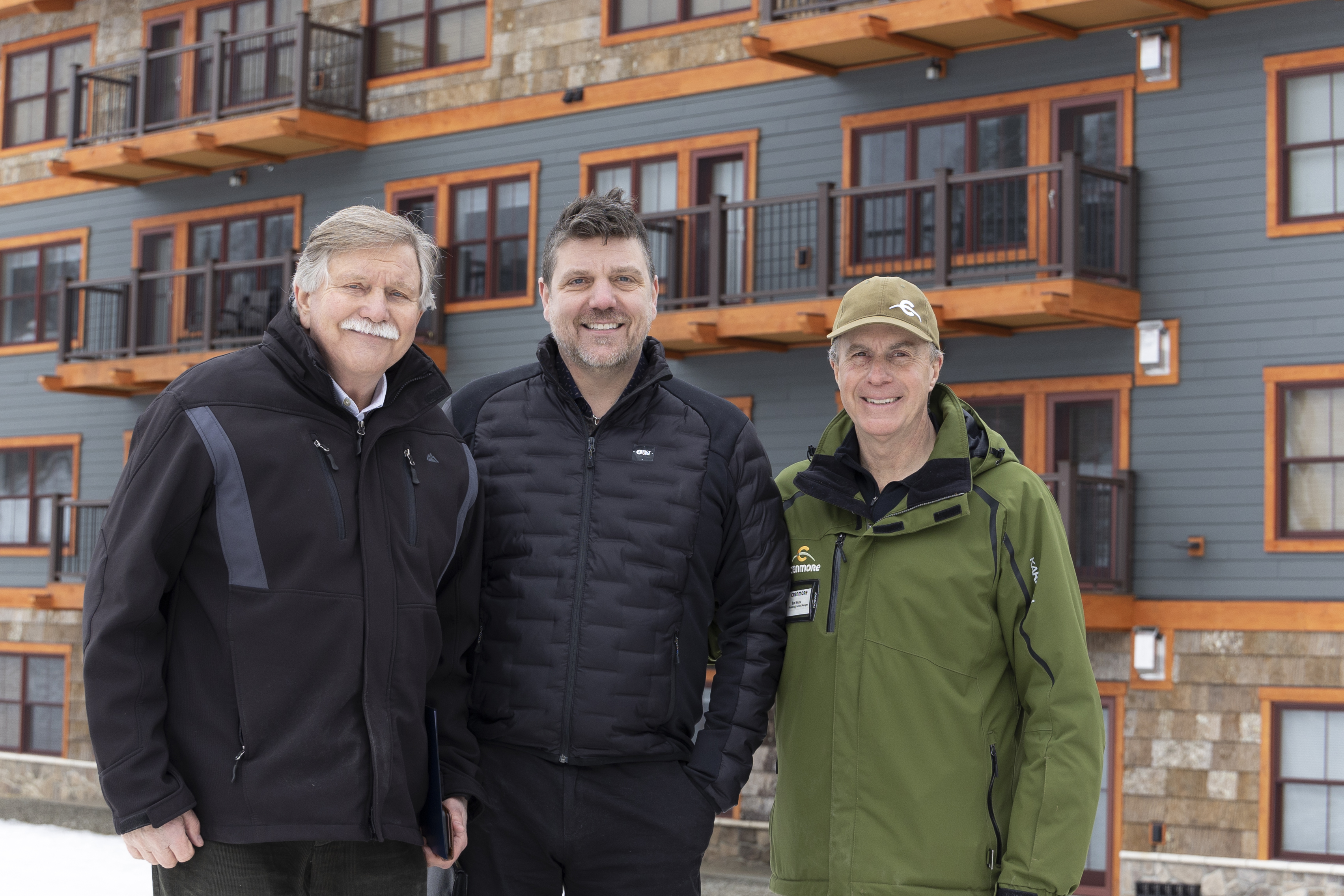
Cranmore
Mountain Resort owners Brian Fairbank, left, and Tyler Fairbank,
center, and general manager Benjamin Wilcox have shepherded the ski
resort through 14 years of growth. (Courtesy of Cranmore Mountain Resort)
As
a result, the views from the parking lot have been severely limited. At
one time, the fabulous statue of Schneider seemed to being skiing right
off the slopes into Cranmore’s drop-off zone. Now, the Father of Modern
Skiing has a backdrop of glistening-if-nondescript buildings.
“They are handsome
structures from the slopes,” says Eastman of the new, multistory lodges.
“The only detriment is that they block the view to some extent of the
slopes when you first get there.
“Those
who remember the old Cranmore miss what it was, and being able to see
the ski slopes without obstruction by the new penthouses,” he says,
noting some natives still grieve the loss of the Skimobile in 1990. “But
those penthouses paid for the new base lodge. And they’ve modernized
the lifts, the snow-making, So, it’s not just real estate development —
improvements have been made to the ski area because there’s capital to
do it.”
That speaks to
the balancing act that Wilcox, as Cranmore’s general manager, performs
on a daily basis. While those trade-offs weren’t ideal, he says, they
were necessary for the ongoing stability of the ski area. In short,
continued investment is the lifeblood that smaller and mid-size ski
areas need to survive.
“I’m
so happy that we are improving Cranmore, but I have also learned that
we have to be very sensitive and continue to work and educate everybody
about what we’re doing and why we’re doing it,” he says. “I’ll still run
into somebody who says,
‘Oh, you built that big wall up in front of Cranmore.’ And I’ll say,
have you been through the wall? Have you been in the building?
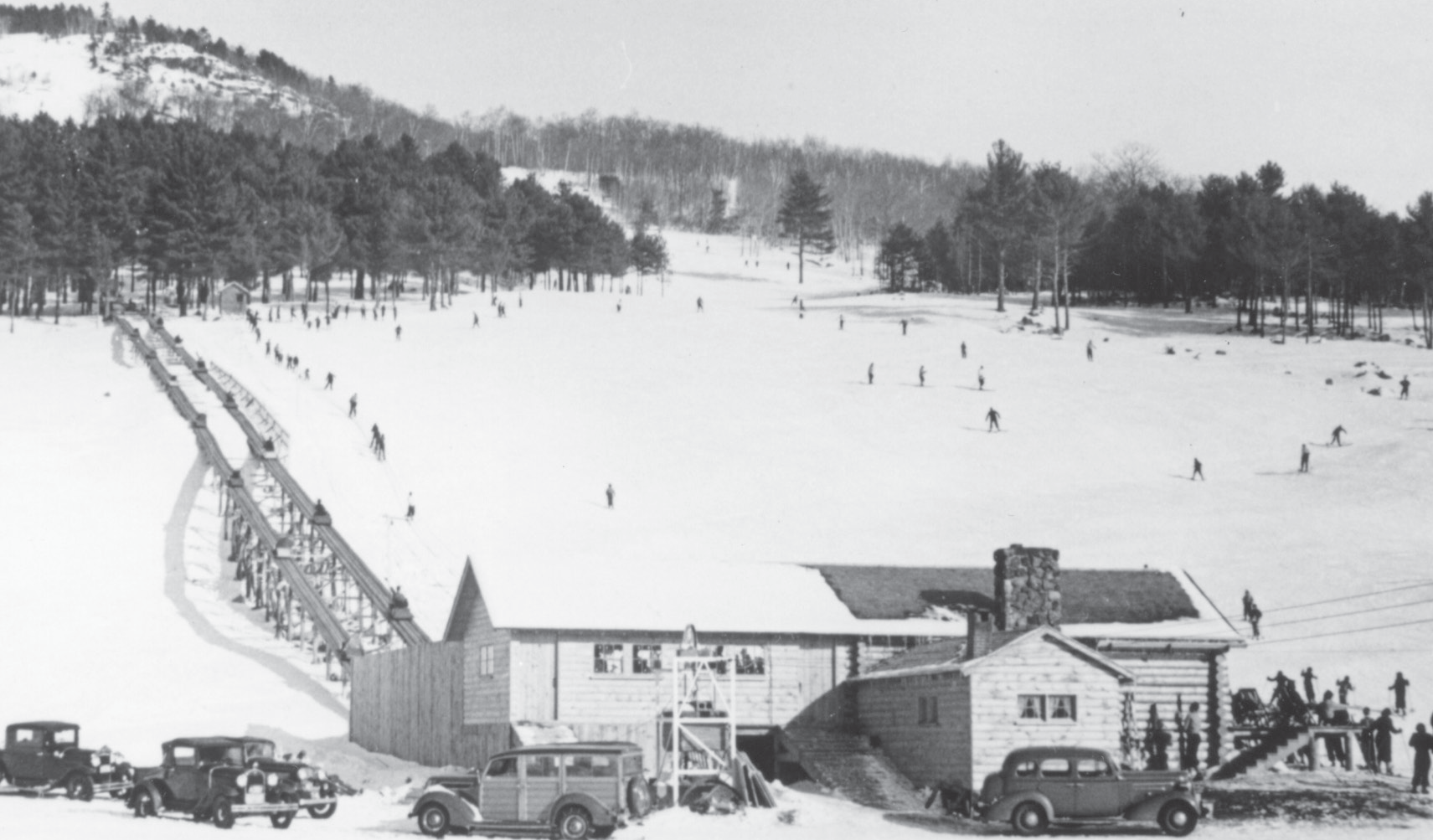
During
the late 1930s and through the 1940s, skiers at Mount Cranmore were
serviced by George Morton’s Skimobile and the area’s original log cabin
lodge. (Courtesy of the North Conway Public Library)
“You
need to come in, you need to go out on the patio, sit out there, watch
the skiers coming down,” says Wilcox, adding the rustic mountaintop
Meister Hut is an untouchable. “We built the ski area so you could come
to the ski area and go ski. I’ve definitely felt the impact of the
change too, but I also realized that once we get through that initial
change, people will see the good, and they’ll be able to plan on having
Cranmore here for the next hundred years.”
Eastman
recalls Christoph Schneider, son of Herbert and grandson of Hannes,
telling him at one Cranmore groundbreaking: “I get asked all the time,
‘Do I miss the Cranmore of my youth? Of course, I do. But I realize that
it had to move on.’” “So, I would say, as a preservationist and ski
historian, part of me longs for the old days,” Eastman says. “But I
understand why Cranmore had to change. I love all the connections to
Cranmore’s past, but I also knew that it was tired and it needed the
capital. And it’s gotten that.”